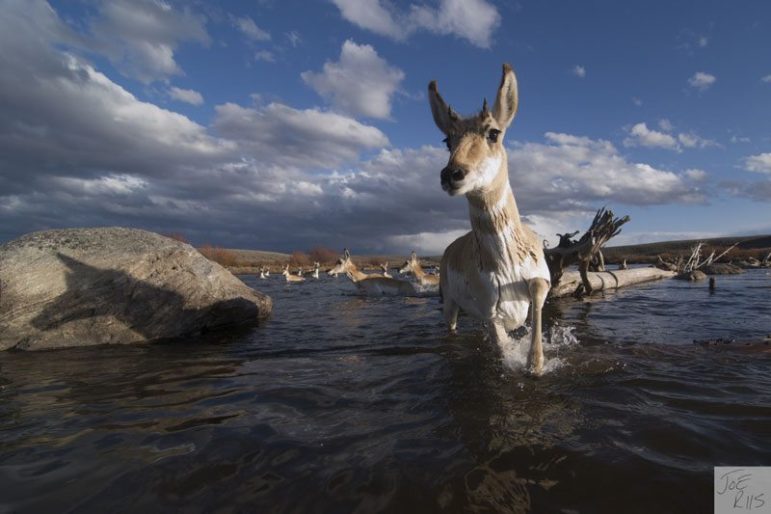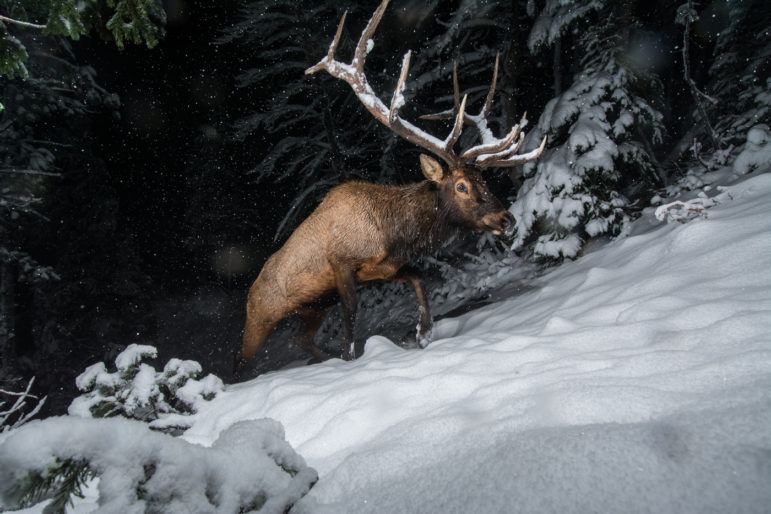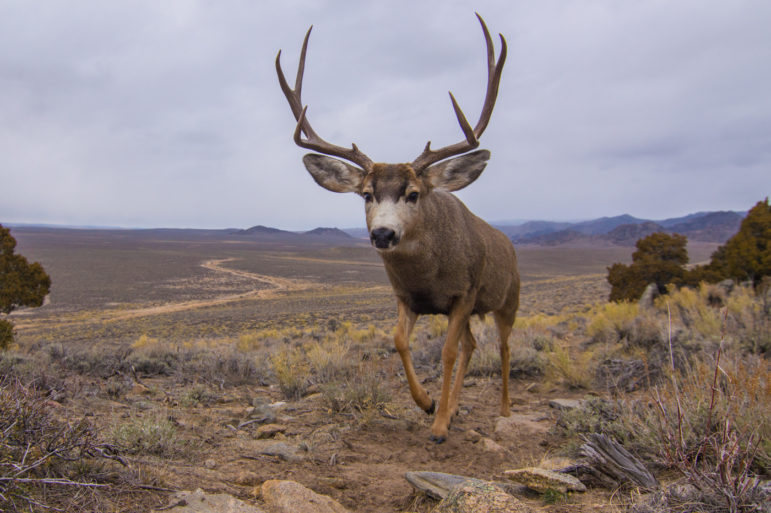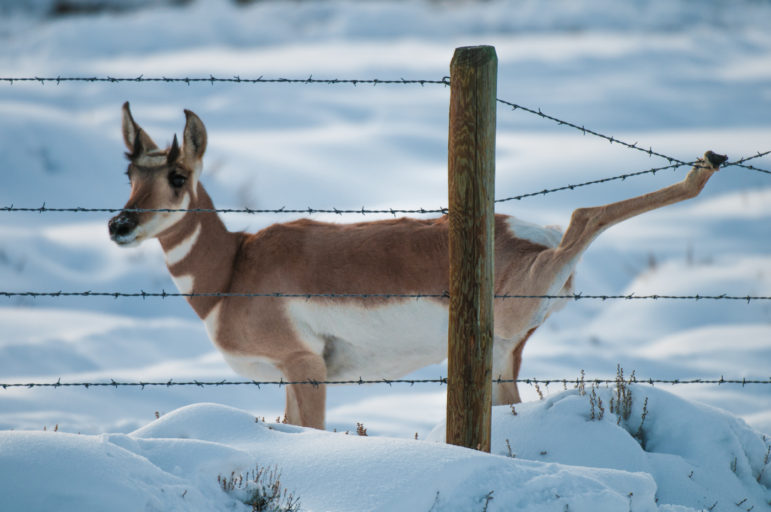
CODY, WYO. — Eagle Pass lies along the southern boundary of Yellowstone National Park, near Eagle Peak, which at 11,372 feet is the highest spot in Yellowstone. It’s not easy to reach, but photojournalist Joe Riis figured it would be a good spot for a remote camera as part of his efforts to document wildlife migrations around the park.
Unfortunately, the camera was in operation only a few days before it was disabled.
“A grizzly bear had hit it, and the camera was pushed down in the dirt,” said Riis, a National Geographic contributing photographer and photography fellow at the Wyoming Migration Initiative. “I thought for sure I hadn’t gotten anything.”
But over the course of just four days, the Eagle Pass camera captured four separate images of a mule deer, bull moose, bull elk and black bear. A single two-page spread in “Yellowstone Migrations,” the new book highlighting Riis’ work, shows the four animals at the same spot. Some are in daylight, others in darkness, some images show the muted colors of fall, others reveal a thick blanket of snow.

A grizzly bear showed up on the Eagle Pass camera trap as well, but the unfocused shot wasn’t included in the book. It was just one of almost 80,000 photos Riis has captured over nearly a decade of work documenting migrations through some of the most rugged and pristine wilderness in the country.
Along the way, Riis has collaborated with a range of partners, such as wildlife ecologist Arthur Middleton, environmental journalist Emilene Ostlind, conservation biologist Thomas Lovejoy and artist James Prosek, all of whom contributed to “Yellowstone Migrations.”
But undoubtedly, it’s the hundreds of arresting photos by Riis that are the star of the book. Because they are taken primarily with camera traps triggered by the motion of their subjects, the photos convey an overwhelming sense of intimacy and omniscient voyeurism that isn’t found in most other wildlife photography.
Pronghorn cross a river in the muted tones of dusk, mule deer climb the sagebrush steppe, elk trudge single-file through deep snow along a high mountain pass. We see it all with an incomprehensible level of detail and from such an immediate proximity as to feel like we are stealing moments that perhaps we have no right to see.
Those decisive moments caught in Riis’ lenses are all the more impressive because of his commitment to making beautiful images without disturbing the animals.

“I’m very interested in not being seen by the animals, and not having an impact on the migration,” he said. “And I’m interested in what’s happening in the backcountry when people aren’t there.”
Riis is increasingly using video cameras from which he can grab a single frame, and also capture audio.
While the bugle of elk is a familiar sound, other ungulates like mule deer make their own distinct vocalizations, Riis said.
“We almost never get close enough to them to be able to hear them, or if we are close enough, they sense we’re there and change their behavior because we’re close,” he said.
For the reader, the photos in “Yellowstone Migrations” offer unearned glimpses into amazing landscapes under beautiful but sometimes brutal conditions. Unearned, that is, except by Riis and those who made the treks to set up the cameras.
“We definitely put in a lot of miles on the trail together,” said Lee Livingston, a Cody, Wyo. outfitter who, together with brother Wes Livingston and their crew, helped guide Riis and his collaborators to wild and remote areas like the Thorofare, a legendary wilderness and migration corridor along the southeastern boundary of Yellowstone.
Such a project “wouldn’t happen without Joe being as tough as he is,” Livingston said. “Anyone who’s willing to throw a backpack on their back with 80 pounds of gear and take it out to a site to take pictures, that’s the kind of guy we need up there.”
Those cameras capture not only wildlife, but the amazing landscape that is the co-star of the migration story. Some cameras take a couple of days to reach on horseback, others are set up just a short walk from a road. Cameras may stay in the field for a year or two, or just a few days. Throughout the process, Riis relies on a wide range of locals to help him know where he should set his camera traps.
“That’s a big part of my goal, for people here to see how awesome the place where they work and live is,” he said. “If there’s one group of people that I want to see and know about these pictures, it’s the local people.”

Riis said he is glad to see Wyoming residents responding to the photos, including one shot of a pronghorn with its back hoof caught between two strands of a barbed wire fence.
“That’s the picture that people most ask me about, they want to know what happened to it,” he said.
Riis saw the trapped pronghorn while driving near Pinedale, and reflexively went to help the animal before realizing it would make a great photo. He snapped a few quick shots before freeing the pronghorn.
The image tells the story of human influences on ancient migration routes, and Riis said he is proud of the response it gets.
But his favorite photo shows a winded elk calf, tongue hanging out, as it scrambles up a steep and rocky trail with others in the herd, all struggling to cross a mountain pass.
“That calf and the calves behind it, on their first migration following their mothers, that is the pulse of what migration is all about,” he said. “Their path isn’t easy, and the elk here in Cody are mountain elk that cross over some of the highest mountain passes that any elk cross over anywhere.”
Photos like the elk calf image — ones where light and shadow, landscape and wildlife, motion and color all come together to create a remarkable spectacle of nature — Riis refers to those pictures as “gifts,” as if to downplay his role in creating them.
He seems happy to share credit with a host of locals, collaborators and even mother nature, so long as the photos are seen by the right people in the right places, particularly those in a position to make sure the Yellowstone migrations continue to thrive.
“I’m just trying to get the kind of intimate pictures that I think people will connect to and see both the animal and the landscape,” he said.
If you go…
Joe Riis and Emilene Ostlind will sign copies of “Yellowstone Migrations” from 11 a.m. – 1 p.m. on Saturday, Nov. 4 at Sheridan Stationery Books and Gallery, 206 N. Main St. in Sheridan. For more information, visit yellowstonemigrations.com.
Contact Ruffin Prevost at 307-213-9818 or [email protected].
